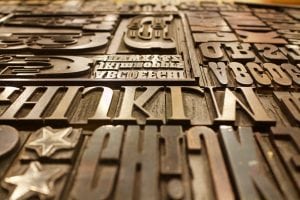Font psychology is as important as color emotions
First of all, the psychology of fonts is crucial to study as it might be a make or break for your business logo design. Furthermore, successful logo designers have to have a deep understanding of topics related to their work. For instance, they must work with clients to choose the right colors and logo shapes to represent their companies. Ultimately, the client’s logo has to do a good job of communicating their company’s core values and brand personality to their customers.
Furthermore, most people don’t give much thought to the fonts they use. So, when creating a document, you might think about readability. However, you probably don’t give much thought to how the font you choose will affect the person who reads it on an emotional or psychological level. Yet the truth is that psychology of fonts matter.
More importantly, the font you choose for your logo says a lot about who you are and what you do. After all, if you choose the wrong one it can be detrimental to your bottom line. Therefore, select wisely and your font can connect with people even if they don’t read the words in your logo.

Understanding Design and Font Psychology
First of all, let’s start by talking about design in a general way. After all, people who have no training in font psychology nor in the science of logo design and often underestimate the thought that goes into it. I must say that in many ways, logo design represents the intersection of art and science.
Gestalt Theory in the Psychology of Fonts
Above all, philosophy students might be familiar with the word ‘gestalt,’ but did you know that it applies to logo design too? For instance, in German, ‘gestalt’ means ‘a unified whole.’ Above all, the theory says that people tend to view disparate parts as a unified whole whenever possible. In other words, we strive to find patterns and meaning even when none is apparent. Strange how the brain works. Therefore, in the psychology of fonts this is important to remember.
Most importantly, how does this apply to logo design? Furthermore, what Gestalt Theory tells us is that it is possible to convey meaning. However only when all of the parts of a whole work together. Therefore, in a logo, that means that the colors, shapes, symbols, fonts, and words must all relate to one another. Understandably and in a harmonious way. In font psychology, even more so, to complicate matters, they must also relate to the company itself – its industry, products, and employees.
Importantly, a logo that adheres to Gestalt Theory is an effective logo. After all, it tells people a great deal about a company as soon as they see it. So for instance take a look at shis logo that we designed is a good example:

Why is this logo effective? The color purple is feminine and luxurious, and gold is its complement. Furthermore, the flower symbolizes femininity and new growth, both of which make sense for a skin care company. Finally, the flowing script font is appropriate for a company in the beauty industry, according to font psychology. So you see, each element of the logo works together to convey a strong, clear message about this company.
How Font Psychology Help Form Impressions of a Brand
The fonts you choose matter. A company that offers financial services should choose a font that conveys reliability, trust, and conservatism – and in fact, many companies in the financial industry use traditional Serif fonts for that reason. A tech company might choose a very modern font and combine it with images that let people know that they innovate and look to the future. Another great example of the psychology of fonts.
Imagine, for a moment, that a financial services company chose a script font like the one in the logo above. The image is jarring, isn’t it? That’s because the style of the font is at odds with the company itself. The font you choose needs to reflect what you do. It should meet your target customers’ expectations of your company.
What do customers expect of you? What are the qualities that they look for in a company in your industry? That information can help you determine the best font to use in your logo.
Overview of Fonts
At this point it may be helpful to look at some font psychology types and explore the messages they convey and the impact they have on people’s brains.
- (a) Serif fonts are respectable, stable, and traditional. They may be a bit old-fashioned for modern industries, but if you want your target audience to feel that they can trust you, they’re a good choice. Many financial services and insurance companies use serif fonts.

- (b) Sans Serif fonts are simple and clean. They convey the message that the company who uses them is straightforward and direct with nothing to hide. Sans Serif fonts are the standard for digital design, including most websites, and that gives them a modern feel.
- (c) Script fonts are feminine and flowing. Because many of them mimic handwriting, they also tend to have a more personal and heartfelt feel than type fonts. Companies in creative industries may decide to use script fonts as a way of communicating with their customers.
- (d) Display fonts are big, bold, and unconventional. They may be appropriate for companies in entertainment – think of the distinctive Disney font as an example. They’re meant to be noticed, but they are not appropriate for most companies.
- (e) Modern fonts are trendy and may be a bit futuristic in appearance. These fonts make a good choice for technical and engineering companies because they send the message that the company that uses them is on the cutting edge.
- (f) Decorative fonts are fun, unique, and distinctive. They can be effective if used properly, but as is the case with Script and Display fonts, it’s easy to overdo it. They should be used sparingly.
Chose a font that has impact on your customer’s view of you
A skilled logo designer can help you zero in on the best options for your brand. More so to determine the psychology of fonts that works best for you. It’s important to remember that if you choose a font that doesn’t match your brand, it may create cognitive dissonance in the people who see it. Earlier, we used the example of a financial services company using a script font. That’s a poor marriage of industry and font style because the font itself contradicts the company’s function and purpose.
Tips for Choosing the Right Fonts
What do you need to know to choose the right font? A lot of business owners are tempted to pick a font that’s unique, but uniqueness is only one of the qualities you should keep in mind. A font might be beautiful, but is it readable? Does it tell people what they need to know about your business?
Should You Use a Fancy Font according to the psychology of fonts?
In the old days, available fonts therefore font psychology, tended to be fairly limited. Because printers relied on manual typesetting, the options were few. The invention and widespread use of computers has led to a revolution in the world font design. When the time comes to pick a logo for your company, you’ll have thousands of fonts to choose from so do consider the font psychology.
You might want a fancy and distinctive font for your logo – and in some cases, an elaborate or distinctive font might be exactly right. However, the key if you do decide to use a fancy font is to focus on readability and appropriateness. If the people who see your logo can read it easily, and if it conveys the proper tone, a fancy font might be the best choice.
Here’s an example of a logo we designed that uses a fancy and distinctive font psychology:

Furthermore, the font in question is big and bold. There’s no question that it’s designed to capture people’s attention. The reason it works for this company is that the font is a direct reflection of what the company does. It has a distinctly Asian feel that works well for a company that teaches Judo. Therefore, that is this company’s font psychology.
The font itself mimics the brush strokes that are used for calligraphy. While Asian characters may also be set in typeface, most Westerners think of them as being handwritten – and that’s what makes this font an effective choice. What makes edgy logo design attractive?
Which Font Best Expresses Your Brand’s Personality?
As you research fonts and talk to your logo designer, here are some questions to ask to determine which font psychology to use.
1. What are the three emotions that I most want people who see my logo to feel? For example, an entertainment company might choose words like excitement, anticipation, and happiness. A finance company might select trust, calm, and optimism. For instance, foreign text logo designs still has to make people feel all over the world. Think about your logo in different languages.
2. What three emotions do you not want people who see your logo to feel? Again, an entertainment company might choose boredom, disinterest, and dread. A financial company might focus on fear, uncertainty, and frivolity.
3. Who is my target audience? Are they young or old? Male or female? Rich or poor? College-educated or blue collar? All of these traits can help you figure out which font will communicate your brand’s message most effectively.
4. Does this font match my brand’s personality? Does it meet people’s expectations for my industry and products?
Asking these questions can help you eliminate fonts that are jarring or ineffective and hone in on the ones that will work with your branding and marketing to help you attract new customers. This excellent study is worth reading in my opinion. See if you agree or disagree. Princeton – making ideas harder to read may make them easier to retain.
Last few words about the psychology of fonts.
The psychology of fonts have a direct impact on the way people perceive your brand. If you select a font for your logo that meets expectations for your industry and matches your brand’s personality, your logo is far more likely to be effective than it would be if you chose a jarring or inappropriate font. Read more about logos with our 3 elements of an edgy logo
